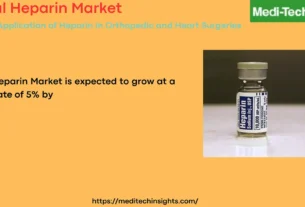
Global Teledermatology Market Overview
The Global Teledermatology Market is projected to grow at a robust CAGR of approximately 15% by 2027, driven by a combination of technological innovation, rising skin disease prevalence, and increasing pressure on healthcare systems to deliver timely dermatological care. As hybrid models gain prominence and telehealth adoption accelerates, teledermatology is emerging as a critical component of modern healthcare delivery.
Download pdf Brochure: https://meditechinsights.com/teledermatology-market/request-sample/
Its ability to bridge the gap between dermatology specialists and patients—especially in regions with workforce shortages—continues to fuel demand. Teledermatology leverages audio, visual, and data communication tools to remotely deliver dermatology-related consultations, diagnosis, and treatment, making it a vital solution for improving access, reducing waiting times, and enhancing care efficiency.
Rising Need for Teledermatology and Expanding Use Cases
The growing incidence of dermatological conditions such as skin cancer, eczema, acne, and psoriasis is increasing the burden on healthcare providers across the world. With many regions experiencing a shortage of dermatologists and skilled clinicians, teledermatology offers a highly accessible and scalable alternative. The technology is particularly valuable in remote and underserved areas, enabling timely intervention and improving outcomes.
Health systems are adopting teledermatology for various applications, including triage, follow-up consultations, chronic disease monitoring, and preventive dermatology. Its convenience and cost-effectiveness encourage widespread acceptance among patients who prefer remote consultations over in-person visits, especially for non-emergency conditions. The shift toward digital healthcare and consumer preference for virtual care continues to strengthen the foundation for teledermatology adoption.
Asynchronous (Store-and-Forward) Teledermatology Leading the Market
Asynchronous or store-and-forward (SAF) teledermatology remains the most widely adopted model due to its efficiency, flexibility, and ability to handle high case volumes.
Reduced waiting time for consultations
Faster triage and prioritization of urgent cases
Ability to manage large patient loads efficiently
Improved patient convenience and satisfaction
SAF enables providers to review high-resolution images and clinical data at their convenience, making it ideal for routine cases and follow-ups. However, the absence of real-time interaction may limit its suitability for complex cases where immediate feedback is necessary.
Hybrid Teledermatology Expected to Gain Significant Momentum
Hybrid teledermatology is quickly emerging as the most promising model due to its ability to combine real-time and asynchronous capabilities. It gives patients the flexibility to choose their preferred mode of consultation and enhances the overall care experience.
Reduced waiting times and shorter diagnosis cycles
Greater accessibility for patients requiring both live interaction and detailed case review
Improved clinical decision-making through comprehensive data exchange
Enhanced patient engagement and satisfaction
The hybrid model is expected to experience rapid adoption as healthcare systems seek more versatile and patient-centric digital care solutions.
Technological Advancements Fueling Market Growth
Rapid technological advancements and the launch of innovative teledermatology platforms are significantly expanding the market. Enhanced image quality, AI-powered diagnostic tools, mobile apps, integrated electronic health record (EHR) systems, and secure cloud platforms are transforming remote dermatology care.
In May 2023, Black Country Provider Collaborative introduced advanced teledermatology services in the UK to triage patients within 24 hours, reduce unnecessary referrals, and streamline access to diagnosis and treatment.
In September 2022, Oro Health partnered with MCI Onehealth to launch MCI Dermatology Connect in Ontario. The platform uses secure telehealth technology to allow patients to receive personalized dermatology consultations, diagnoses, and prescriptions within a few days.
Such initiatives highlight the growing recognition of teledermatology as a reliable tool to modernize dermatological care and reduce the burden on health systems.
Competitive Landscape
The teledermatology market is highly competitive, with players continuously introducing new technologies, expanding geographic reach, and integrating advanced diagnostics. The market includes telemedicine leaders, dermatology-focused digital health platforms, healthcare software providers, and virtual care specialists.
Key Players
• MedX Health
• Digital Diagnostics / 3Derm Systems
• MetaOptima
• Miiskin
• Hims & Hers
• Mandel Dermatology
• MDLIVE
• Medweb
• First Derm
• Dermicus
• Eagle Telemedicine
• Advanced Telemed Services
• SkyMD
• Integrated Dermatology
• Curology
Growth Strategies Adopted by Key Players
Companies in this market are expanding through both organic and inorganic strategies to strengthen their positions and enhance service offerings. New product launches, pilot programs, strategic partnerships, and acquisitions form the core of their growth plans.
In April 2023, MedX Health entered an agreement with PharmaChoice Canada to deploy its teledermatology screening platform across over 1,000 pharmacies, making dermatology assessments more accessible nationwide.
In July 2021, Hims & Hers Health acquired Apostrophe, a specialized teledermatology provider, enabling the company to offer more advanced and personalized dermatology treatments at scale.
As telehealth integration deepens and healthcare providers increasingly invest in digital transformation, teledermatology companies are focusing on developing secure, user-friendly platforms that offer accurate diagnostics and improved patient outcomes.
Future Outlook and Emerging Opportunities
The teledermatology market is expected to gain strong momentum over the coming years due to the integration of artificial intelligence (AI) and machine learning tools capable of improving diagnostic accuracy and clinical decision-making. AI-enhanced image analysis will help clinicians detect skin abnormalities faster and more precisely. Automated workflows and clinical decision support tools will reduce administrative burdens and speed up case processing.
Increasing patient awareness and acceptance of telehealth, coupled with rising provider adoption, will contribute to continued market growth. Government support for digital healthcare infrastructure and insurance coverage for teleconsultations will further accelerate expansion. With growing demand, companies are expected to invest more in research, expand their networks, and provide more comprehensive dermatology care solutions.
Key Drivers
Advent of hybrid teledermatology
Growing cases of skin diseases such as skin cancer, eczema, and psoriasis
Shortage of dermatologists and skilled clinicians
Technological advancements in teledermatology products and introduction of new services
Download pdf Brochure: https://meditechinsights.com/teledermatology-market/request-sample/
About Medi-Tech Insights
Medi-Tech Insights is a healthcare-focused business research & insights firm. Our clients include Fortune 500 companies, blue-chip investors & hyper-growth start-ups. We have completed 100+ projects in Digital Health, Healthcare IT, Medical Technology, Medical Devices & Pharma Services in the areas of market assessments, due diligence, competitive intelligence, market sizing and forecasting, pricing analysis & go-to-market strategy. Our methodology includes rigorous secondary research combined with deep-dive interviews with industry-leading CXO, VPs, and key demand/supply side decision-makers.

